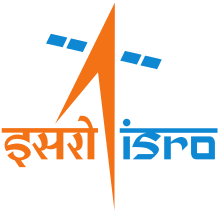Polar Satellite Launch Vehicle
The Polar Satellite Launch Vehicle (PSLV) is an expendable medium-lift launch vehicle designed and operated by the Indian Space Research Organisation (ISRO). It was developed to allow India to launch its Indian Remote Sensing (IRS) satellites into sun-synchronous orbits, a service that was, until the advent of the PSLV in 1993, commercially available only from Russia. PSLV can also launch small size satellites into Geostationary Transfer Orbit (GTO).[8]
.jpg) PSLV C35 on launch pad | |
| Function | Medium lift launch system |
|---|---|
| Manufacturer | ISRO |
| Country of origin | India |
| Cost per launch | ₹130 crore (US$18 million) -₹200 crore (US$28 million) [1] |
| Size | |
| Height | 44 m (144 ft) |
| Diameter | 2.8 m (9 ft 2 in) |
| Mass | PSLV-G: 295,000 kg (650,000 lb) PSLV-CA: 230,000 kg (510,000 lb) PSLV-XL: 320,000 kg (710,000 lb)[2] |
| Stages | 4 |
| Capacity | |
| Payload to LEO | 3,800 kg (8,400 lb)[3] |
| Payload to SSO | 1,750 kg (3,860 lb)[2] |
| Payload to Sub-GTO | 1,425 kg (3,142 lb)[2] |
| Payload to GTO | 1,200 kg (2,600 lb)[4] |
| Launch history | |
| Status | Active |
| Launch sites | Sriharikota |
| Total launches | 50 |
| Successes | 47 |
| Failures | 2 |
| Partial failures | 1 |
| First flight |
|
| Last flight |
|
| Notable payloads | Chandrayaan-1, Mars Orbiter Mission, Astrosat, SRE-1, NAVIC |
| Boosters (PSLV-G) – S9 | |
| No. boosters | 6 |
| Thrust | 510 kN (110,000 lbf) |
| Specific impulse | 262 s (2.57 km/s) |
| Burn time | 44 seconds |
| Fuel | HTPB |
| Boosters (PSLV-XL/QL/DL) – S12 | |
| No. boosters | 6 (XL) 4 (QL) 2 (DL) |
| Length | 12 m (39 ft)[5] |
| Diameter | 1 m (3.3 ft)[5] |
| Propellant mass | 12,200 kg (26,900 lb) each[5] |
| Thrust | 703.5 kN (158,200 lbf) [6] |
| Total thrust | 4,221 kN (949,000 lbf) (XL) 2,814 kN (633,000 lbf) (QL) 1,407 kN (316,000 lbf) (DL) |
| Specific impulse | 262 s (2.57 km/s) |
| Burn time | 70 seconds [6] |
| Fuel | HTPB |
| First stage | |
| Length | 20 m (66 ft)[5] |
| Diameter | 2.8 m (9.2 ft)[5] |
| Propellant mass | 138,200 kg (304,700 lb) each[5][2] |
| Motor | S139 |
| Thrust | 4,846.9 kN (1,089,600 lbf) [6] |
| Specific impulse | 237 s (2.32 km/s) (sea level) 269 s (2.64 km/s) (vacuum) |
| Burn time | 110 seconds [6] |
| Fuel | HTPB |
| Second stage | |
| Length | 12.8 m (42 ft)[5] |
| Diameter | 2.8 m (9.2 ft)[5] |
| Propellant mass | 42,000 kg (93,000 lb) each[5] |
| Engines | 1 Vikas |
| Thrust | 803.7 kN (180,700 lbf) [6] |
| Specific impulse | 293 s (2.87 km/s) |
| Burn time | 133 seconds [6] |
| Fuel | N2O4/UDMH |
| Third stage | |
| Length | 3.6 m (12 ft)[5] |
| Diameter | 2 m (6.6 ft)[5] |
| Propellant mass | 7,600 kg (16,800 lb) each[5] |
| Motor | S-7[7] |
| Thrust | 240 kN (54,000 lbf) |
| Specific impulse | 295 s (2.89 km/s) |
| Burn time | 83 seconds |
| Fuel | HTPB |
| Fourth stage | |
| Length | 3 m (9.8 ft)[5] |
| Diameter | 1.3 m (4.3 ft)[5] |
| Propellant mass | 2,500 kg (5,500 lb) each[5] |
| Engines | 2 x L-2-5[7] |
| Thrust | 14.66 kN (3,300 lbf) [6] |
| Specific impulse | 308 s (3.02 km/s) |
| Burn time | 425 seconds |
| Fuel | MMH/MON |
Some notable payloads launched by PSLV include India's first lunar probe Chandrayaan-1, India's first interplanetary mission, Mars Orbiter Mission (Mangalyaan) and India's first space observatory, Astrosat.[2]
PSLV has gained credence as a leading provider of rideshare services for small satellites, due its numerous multi-satellite deployment campaigns with auxiliary payloads usually ride sharing along an Indian primary payload.[9] As of December 2019, PSLV has launched 319 foreign satellites from 33 countries.[10] Most notable among these was the launch of PSLV C37 on 15 February 2017, successfully deploying 104 satellites in sun-synchronous orbit, tripling the previous record held by Russia for the highest number of satellites sent to space on a single launch.[11][12]
Payloads can be integrated in tandem configuration employing a Dual Launch Adapter.[13][14] Smaller payloads are also placed on equipment deck and customized payload adapters.[15]
Development

Studies to develop a vehicle capable of delivering 600 kg payload to 550 km Sun-synchronous orbit from SHAR began in 1978. Among 35 proposed configurations, four were picked and by November 1980, a vehicle configuration with two strap-ons on a core booster (S80) with 80 tonne solid propellant loading each, a liquid stage with 30 tonne propellant load (L30) and an upper stage called Perigee-Apogee System (PAS) was being considered.[16][17][18][19]
By 1981, confidence grew in remote sensing spacecraft development with launch of Bhaskara-1 and the PSLV project objectives were upgraded to have vehicle deliver 1000 kg payload in 900 km SSO. As technology transfer of Viking rocket engine firmed up, a new lighter configuration shifting away from relying on three large solid boosters was proposed by team led by APJ Abdul Kalam and eventually selected.[20][21] Funding was approved in July 1982 for finalized design employing a single large S125 solid core as first stage with six 9 tonne strap-ons (S9) derived from SLV-3 first stage, liquid fueled second stage (L33) and two solid upper stages S7 and S2. This configuration needed further improvement to meet the orbital injection accuracy requirements of IRS satellites and hence solid terminal stage (S2) was replaced with a pressure fed liquid fueled stage (L1.8 or LUS) powered by twin engines derived from roll control engines of first stage. Apart from increasing precision, liquid upper stage also absorbed any deviation in performance of solid third stage. Final configuration of PSLV D1 to fly in 1993 was (6 × S9 + S125) + L37.5 + S7 + L2.[17][18]
The inertial navigation systems are developed by ISRO Inertial Systems Unit (IISU) at Thiruvananthapuram. The liquid propulsion stages for the second and fourth stages of PSLV as well as the Reaction control systems (RCS) are developed by the Liquid Propulsion Systems Centre (LPSC) at Mahendragiri near Tirunelveli, Tamil Nadu. The solid propellant motors are processed at Satish Dhawan Space Centre (SHAR) at Sriharikota, Andhra Pradesh which also carries out launch operations.
The PSLV was first launched on 20 September 1993. The first and second stages performed as expected, but an attitude control problem led to the collision of the second and third stages at separation, and the payload failed to reach orbit.[22] After this initial setback, the PSLV successfully completed its second mission in 1994.[23] The fourth launch of PSLV suffered a partial failure in 1997, leaving its payload in a lower than planned orbit. By Nov 2014 the PSLV had launched 34 times with no further failures.[24] (Although launch 41: August 2017 PSLV-C39 was unsuccessful.[2])
PSLV continues to support Indian and foreign satellite launches especially for low Earth orbit (LEO) satellites. It has undergone several improvements with each subsequent version, especially those involving thrust, efficiency as well as weight. In November 2013, it was used to launch the Mars Orbiter Mission, India's first interplanetary probe.[25]
ISRO is planning to privatise the operations of PSLV and will work through a joint venture with private industries. The integration and launch will be managed an industrial consortium through Antrix Corporation.[26]
In June 2018, the Union Cabinet approved ₹6,131 crore (US$860 million) for 30 operational flights of the PSLV scheduled to take place between 2019 and 2024.[27]
Vehicle description
The PSLV has four stages using solid and liquid propulsion systems alternately.
First stage (PS1)
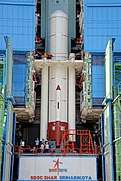
The first stage, one of the largest solid rocket boosters in the world, carries 138 t (304,000 lb) tonnes of hydroxyl-terminated polybutadiene-bound (HTPB) propellant and develops a maximum thrust of about 4,800 kilonewtons (1,100,000 lbf). The 2.8 m (9 ft 2 in) diameter motor case is made of maraging steel and has an empty mass of 30,200 kilograms (66,600 lb).[7]
Pitch and yaw control during first stage flight is provided by the Secondary Injection Thrust Vector Control System (SITVC), which injects an aqueous solution of strontium perchlorate into the S139 exhaust divergent from a ring of 24 injection ports to produce asymmetric thrust. The solution is stored in two cylindrical aluminium tanks strapped to the core solid rocket motor and pressurised with nitrogen. Underneath these two SITVC tanks, Roll Control Thruster (RCT) modules with small bi-propellant (MMH/MON) liquid engine are also attached.[28]
On the PSLV-G and PSLV-XL, first stage thrust is augmented by six strap-on solid boosters. Four boosters are ground-lit and the remaining two ignite 25 seconds after launch. The solid boosters carry 9 t (20,000 lb) or 12 t (26,000 lb) (for PSLV-XL configuration) propellant and produce 510 kN (110,000 lbf) and 719 kN (162,000 lbf) thrust respectively. Two strap-on boosters are equipped with SITVC for additional attitude control.[7] The PSLV-CA uses no strap-on boosters.
First stage separation is aided by four pairs of retro-rockets installed on inter-stage (1/2L). During staging, these eight rockets help push away the spent stage away from second stage.[29]
Second stage (PS2)
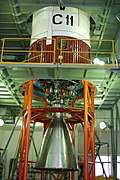
The second stage is powered by a single Vikas engine and carries 41.5 t (91,000 lb) of Earth store-able liquid propellant – unsymmetrical dimethylhydrazine (UDMH) as fuel and nitrogen tetroxide (N2O4) as oxidiser in two tanks separated by a common bulkhead.[28] It generates a maximum thrust of 800 kN (180,000 lbf). The engine is gimbaled (±4°) in two planes to provide pitch and yaw control by two actuators, while roll control is provided by a Hot gas Reaction Control Motor (HRCM) that ejects hot gases diverted from gas generator of Vikas engine.[30]
On inter-stage (1/2U) of PS2 there are two pairs of ullage rockets to maintain positive acceleration during PS1/PS2 staging and also two pairs of retro-rockets to help push away spent stage during PS2/PS3 staging.[29]
Second stage also carries some quantity of water in a toroidal tank at its bottom.[31] Water spray is used to cool hot gases from Vikas' gas generator before entering turbopump.[32]
Third stage (PS3)
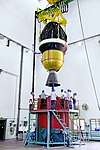
The third stage uses 7 t (15,000 lb) of hydroxyl-terminated polybutadiene-based solid propellant and produces a maximum thrust of 240 kN (54,000 lbf). It has a Kevlar-polyamide fibre case and a submerged nozzle equipped with a flex-bearing-seal gimbaled nozzle (±2°) thrust vector engine for pitch & yaw control. Roll control is provided by the fourth stage reaction control system (RCS) during thrust phase as well as during combined-coasting phase.[7]
Fourth stage (PS4)
The fourth stage is powered by regeneratively cooled twin engines,[33] burning monomethylhydrazine (MMH) and mixed oxides of nitrogen (MON). Each engine generates 7.4 kN (1,700 lbf) thrust and is gimbaled (±3°) to provide pitch, yaw & roll control during powered flight. Coast phase attitude control is provided by RCS. The stage carries up to 2,500 kg (5,500 lb) of propellant in the PSLV and PSLV-XL and 2,100 kg (4,600 lb) in the PSLV-CA.[34]
PS4 stage as orbital platform
PS4 has carried hosted payloads like AAM on PSLV-C8,[31] Rubin 9.1/ Rubin 9.2 on PSLV-C14[35] and mRESINS on PSLV-C21.[36] But now PS4 is being augmented to serve as a long duration orbital platform after completion of primary mission. PS4 Orbital Platform (PS4-OP) will have its own power supply, telemetry package, data storage and attitude control for hosted payloads.[37][38][39]
On PSLV-C37 and PSLV C38 campaigns, as a demonstration PS4 was kept operational and monitored for over ten orbits after delivering spacecrafts.[40][41][42]
PSLV-C44 was the first campaign where PS4 functioned as independent orbital platform for short duration as there was no on-board power generation capacity.[43] It carried KalamSAT-V2 as a fixed payload, a 1U cubesat by Space Kidz India based on Interorbital Systems kit.[44][45]
On PSLV-C45 campaign the fourth stage had its own power generation capability as it was augmented with an array of fixed solar cells around PS4 propellant tank.[46] Three payloads hosted on PS4-OP were, Advanced Retarding Potential Analyzer for Ionospheric Studies (ARIS 101F) by IIST,[47] experimental AIS payload by ISRO and AISAT by Satellize.[48]
Payload fairing
Payload fairing of PSLV, also referred as its 'Heatshield' weighs 1,182 kg and has 3.2 meter diameter. It has isogrid construction and is made out of 7075 aluminum alloy with a 3 mm thick steel nose cap. The two halves of fairing are separated using a pyrotechnic device based jettisoning system consisting horizontal and vertical separation mechanisms.[49][28][50][51]
| Stage 1 | Stage 2 | Stage 3 | Stage 4 | |
|---|---|---|---|---|
| Pitch | SITVC | Engine Gimbal | Nozzle Flex | Engine Gimbal |
| Yaw | SITVC | Engine Gimbal | Nozzle Flex | Engine Gimbal |
| Roll | RCT and SITVC in 2 PSOMs | HRCM Hot Gas Reaction Control Motor | PS4 RCS | PS4 RCS |
Variants
ISRO has envisaged a number of variants of PSLV to cater to different mission requirements. There are currently two operational versions of the PSLV — the core-alone (PSLV-CA) without strap-on motors, and the (PSLV-XL) version, with six extended length (XL) strap-on motors carrying 12 tonnes of HTPB based propellant each.[52] These configurations provide wide variations in payload capabilities up to 3,800 kg (8,400 lb) in LEO and 1,800 kg (4,000 lb) in sun-synchronous orbit.
PSLV-G (retired)
The standard or "Generic" version of the PSLV, PSLV-G had four stages using solid and liquid propulsion systems alternately and six strap-on motors (PSOM or S9) with 9 tonne propellant loading. It had capability to launch 1,678 kg (3,699 lb) to 622 km (386 mi) into sun-synchronous orbit. PSLV-C35 was the last operational launch of PSLV-G before its discontinuation.[53][54][55]
PSLV-CA
The PSLV-CA, CA meaning "Core Alone", model premiered on 23 April 2007. The CA model does not include the six strap-on boosters used by the PSLV standard variant but two SITVC tanks with Roll Control Thruster modules are still attached to the side of the first stage with addition of two cylindrical aerodynamic stabilizers.[34][55] The fourth stage of the CA variant has 400 kg (880 lb) less propellant when compared to its standard version.[34] It currently has capability to launch 1,100 kg (2,400 lb) to 622 km (386 mi) Sun synchronous orbit.[56]
PSLV-XL
PSLV-XL is the upgraded version of Polar Satellite Launch Vehicle in its standard configuration boosted by more powerful, stretched strap-on boosters with 12 tonne propellant load.[34] Weighing 320 t (710,000 lb) at lift-off, the vehicle uses larger strap-on motors (PSOM-XL or S12) to achieve higher payload capability.[57] On 29 December 2005, ISRO successfully tested the improved version of strap-on booster for the PSLV.[58] The first use of PSLV-XL was the launch of Chandrayaan-1 by PSLV C11. The payload capability for this variant is 1,800 kg (4,000 lb) to SSO.[56]
PSLV-DL
PSLV-DL variant has only two strap-on boosters with 12 tonne propellant load on them. PSLV-C44 on 24 January 2019 was the first flight to use PSLV-DL variant of Polar Satellite Launch Vehicle.[59][60]
PSLV-QL
PSLV-QL variant has four ground-lit strap-on boosters, each with 12 tonnes of propellant. PSLV-C45 on 1 April 2019 was the first flight of PSLV-QL.[61]
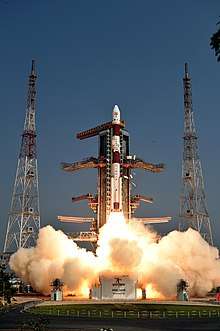
Launch history
As of 11 December 2019 the PSLV has made 50 launches, with 47 successfully reaching their planned orbits, two outright failures and one partial failure, yielding a success rate of 94% (or 96% including the partial failure).[66] All launches have occurred from the Satish Dhawan Space Centre, known before 2002 as the Sriharikota Range (SHAR).
| Variant | Launches | Successes | Failures | Partial failures |
|---|---|---|---|---|
| PSLV-G (Standard) | 12 | 10 | 1 | 1 |
| PSLV-CA (Core Alone) | 14 | 14 | 0 | 0 |
| PSLV-XL (Extended)[2] | 22 | 21 | 1 | 0 |
| PSLV-DL[2] | 1 | 1 | 0 | 0 |
| PSLV-QL[2] | 2 | 2 | 0 | 0 |
| Total as of December 2019[67] | 50 | 47 | 2 | 1 |
See also
- GSLV Mark II
- GSLV Mark III
- Comparison of orbital launchers families
- Medium-lift launch vehicle, 2,000 to 20,000 kg to LEO
- Comparison of orbital rocket engines
- Comparison of orbital launch systems
References
- "SURPLUS MISSILE MOTORS: Sale Price Drives Potential Effects on DOD and Commercial Launch Providers". GAO.gov. U.S. Government Accountability Office. 16 August 2017. Retrieved 2 May 2018.
- "Polar Satellite Launch Vehicle". Retrieved 21 December 2014.
- "Access to Space" (PDF). 2011. Retrieved 8 March 2017.
- "ISRO at India Mobile Congress 2017". Retrieved 29 September 2017.
- "PSLV-C37 Brochure". ISRO.
- "PSLV_C41_Brochure" (PDF). Archived from the original (PDF) on 9 April 2018. Retrieved 9 April 2018.
- "PSLV Launch Vehicle Information". Spaceflight 101. Archived from the original on 24 September 2015. Retrieved 20 February 2015.
- "Welcome To ISRO :: Launch Vehicles". Retrieved 8 April 2014.
- Foust, Jeff. "Rideshare demand grows despite development of small launch vehicles". SPACENEWS. Retrieved 23 June 2017.
- Tejonmayam, U (11 December 2019). "PSLV-C48 successfully launches RISAT-2BRI, 9 foreign satellites". The Times of India. Retrieved 11 December 2019.
- Barry, Ellen (15 February 2017). "India Launches 104 Satellites From a Single Rocket, Ramping Up Space Race". The New York Times. ISSN 0362-4331. Retrieved 15 February 2017.
- "ISRO's record satellites' launch: 10 top facts – Times of India". The Times of India. Retrieved 15 February 2017.
- "PSLV C35 / Scatsat-1 with Dual Launch Adapter". Retrieved 19 December 2017.
- Cong, Indian Science (5 January 2016). "Here's the #103ISC Official Newsletter 2nd edition brought by Journalism students and researchers. 2/2 @PIB_Indiapic.twitter.com/mLq9CZnY5T". @103ISC. Retrieved 19 December 2017.
- "The DMC3 Constellation launch in photos". Retrieved 19 December 2017.
- "Indian ambitions in space go sky-high". New Scientist. 22 January 1981. p. 215.
- Rao, P.V. Monoranjan; Radhakrishnan, Paramaswaran (2012). A brief history of rocketry in ISRO. Orient Blackswan. p. 215. ISBN 978-8173717642.
- Rao, P.V. Manoranjan, ed. (2015). "2.6 PSLV: The workhorse of ISRO by N. Narayanamoorthy". From fishing hamlet to red planet. Harpercollins. ISBN 978-9351776895.
- Raj, Gopal (2000). "8. PSLV: Achieving Operational Launch Capability". Reach For the Stars: The Evolution of India's Rocket Programme. Viking. ISBN 978-0670899500.
About a year later, an important change was made, with the solid fourth stage being substituted by a liquid stage. This change was considered necessary since the accuracy with which the IRS satellites had to be put into orbit — within 15 km in terms of orbital height and within 0.1 degree of the desired orbital inclination — could not be achieved with a solid stage.
- "APJ Abdul Kalam's contribution in making India a member of space club". News18. Retrieved 14 October 2018.
- Abdul, Kalam A. P. J. (2010). Ignited Minds: Unleashing The Power Within India. Pearson Education India. p. 34. ISBN 978-81-317-2960-1.
- "India (Launchers)". Spacecraft Encyclopedia. Retrieved 12 November 2014.
- "PSLV (1)". Gunter's Space Page. Retrieved 12 November 2014.
- "PSLV". Gunter's Space Page. Retrieved 12 November 2014.
- "Welcome To ISRO :: Mars Orbiter Mission". Retrieved 8 April 2014.
- "ISRO looks at JV for PSLV manufacture; launch to be privatized by 2020". Geospatial World. 26 October 2017. Retrieved 26 October 2017.
- "Government approves Rs 10,000-crore continuation programmes for PSLV, GSLV". The Economic Times. 7 June 2018. Retrieved 8 June 2018.
- "Current Science (Volume 65 - Issue 07) PSLV-D1" (PDF). 10 October 1993. Retrieved 20 December 2019.
- "PSLV-C1". www.isro.gov.in. Retrieved 22 February 2020.
- "Space India 1/1990". www.isro.gov.in. Retrieved 22 February 2020.
- "PSLV C8 / AGILE brochure" (PDF).
- Envisioning An Empowered nation. p. 40. ISBN 978-0070531543.
- "ASACO sub-systems for space". Archived from the original on 11 December 2017. Retrieved 16 October 2018.
- "PSLV Datasheet".
- "PSLV C14/Oceansat-2 brochure" (PDF).
- "Space-India July 2012 to August 2013" (PDF).
- "Opportunities for science experiments in the fourth stage of India's PSLV" (PDF). 21 February 2019.
- "Announcement of Opportunity (AO) for Orbital platform: An avenue for in-orbit scientific experiments" (PDF). 15 June 2019.
- Jun 15, Chethan Kumar | TNN |; 2019; Ist, 14:56. "2 days after Space Station news, Isro calls for 'docking experiments' on PSLV stage-4 | India News - Times of India". The Times of India. Retrieved 23 February 2020.CS1 maint: numeric names: authors list (link)
- "Department of Space Annual Report 2017-18" (PDF). Archived (PDF) from the original on 13 February 2018.
- Dec 16, Surendra Singh | TNN | Updated:; 2018; Ist, 14:46. "In a first, Isro will make dead rocket stage 'alive' in space for experiments | India News - Times of India". The Times of India. Retrieved 23 February 2020.CS1 maint: extra punctuation (link) CS1 maint: numeric names: authors list (link)
- rajasekhar, pathri (20 June 2017). "Isro to lower rocket's altitude". Deccan Chronicle. Retrieved 23 February 2020.
- Rajwi, Tiki (12 January 2019). "PSLV lift-off with added features". The Hindu. ISSN 0971-751X. Retrieved 23 February 2020.
- "PSLV-C44 - ISRO". www.isro.gov.in. Retrieved 26 June 2020.
- Interorbital Systems [@interorbital] (25 January 2019). "Congratulations to ISRO & SpaceKidzIndia on getting their CubeSat into orbit! The students modified their IOS CubeSat kit, complete w/ their own experiments!" (Tweet) – via Twitter.
- Clark, Stephen. "Indian military satellite, 20 more Planet imaging CubeSats launched by PSLV – Spaceflight Now". Retrieved 23 February 2020.
- "Department of Avionics, R. Sudharshan Kaarthik, Ph.D (Assistant Professor)".
- "Exseed Sat-2 – Satellize". Retrieved 23 February 2020.
- Singh, Satyendra (11 December 2019). "IRNSS-1H/PSLV-C39 Orbit Evolution and Re-entry Analysis" (PDF). Retrieved 19 December 2019.
- Ramamurti, V; Rajarajan, S; Rao, G Venkateswara (October 2001). "Dynamic studies of a typical payload fairing for different boat tail configurations" (PDF).
- Indigenous Development of Materials for Space Programme. 21 August 2015. Event occurs at 20 minutes 40 seconds.
- Subramanian, T.S. (15 July 2011). "The PSLV is a proud symbol of ISRO's self-reliance". The Hindu. Chennai, India.
- "Where India reaches for the stars: Inside ISRO's Sriharikota Centre". Hindustan Times. 22 June 2016. Retrieved 15 September 2018.
Today, the PSLV is available in three configurations — the generic vehicle with six strap-ons, which is the earlier edition of PSLV (which will be discontinued soon)
- "Outcome Budget 2016–2017" (PDF). Government of India, Department of Space. 2016. Retrieved 15 September 2018.
Currently, two versions of PSLV are operational, namely PSLV-XL (with six extended version of Strap-on motors) and the PSLV Core-alone (without Strap-on motors).
- "2.6 PSLV: The Workhorse of ISRO by N. Narayanamoorthy". From Fishing Hamlet to Red Planet: India's Space Journey. Harpercollins. 2015. ISBN 978-9351776895.
- "India's PSLV" (PDF). www.earth2orbit.com. 15 March 2009. Archived from the original (PDF) on 10 July 2011.
- PSLV-C11 Successfully Launches Chandrayaan-1 Archived 25 October 2008 at the Wayback Machine
- "New Solid Propellant Motor to Increase PSLV Capability". ISRO. Archived from the original on 17 February 2009. Retrieved 27 April 2007.
- Rajwi, Tiki. "SLV-C44 to lift-off with added features". Retrieved 11 January 2019.
- Rajwi, Tiki (12 January 2019). "PSLV lift-off with added features". The Hindu. ISSN 0971-751X. Retrieved 12 January 2019.
- "Launch Kit C45". ISRO. Retrieved 23 March 2019.
- "Evolution of Indian launch vehicle technologies" (PDF). www.ias.ac.in. Indian Academy of Sciences. 25 December 2007. Archived from the original (PDF) on 24 May 2011.
- "Future of Space Transportation: S. Somanath" (PDF). 9 February 2016. Archived from the original (PDF) on 24 October 2018.
- Murthi, K.R. Sridhara (9 May 2009). "Space Debris Mitigation – Coordination and Implementation efforts in India" (PDF). Retrieved 22 November 2017.
- "ISRO's baby rocket to carry small satellites, likely to take off in 2019". The New Indian Express. Retrieved 2 January 2018.
- "PSLV- The Travel Beyond the Blue! #ISRO #VikatanInfographic". www.vikatan.com (in Tamil). Retrieved 20 February 2017.
- "Polar Satellite Launch Vehicle". Retrieved 29 November 2018.
External links
| Wikimedia Commons has media related to Polar Satellite Launch Vehicle. |
